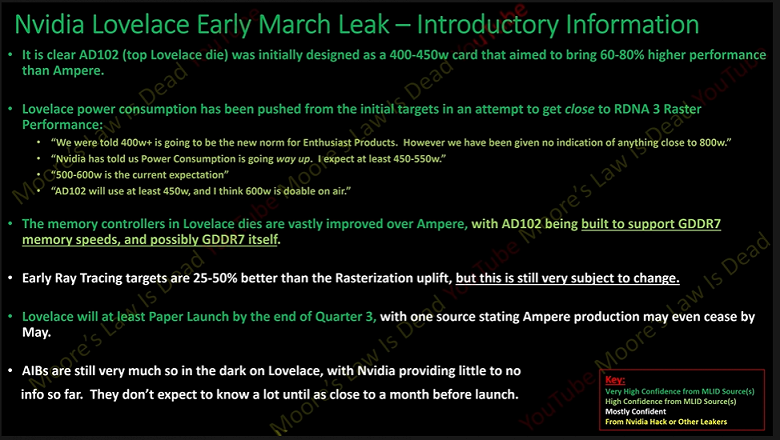Detailed and very interesting details about Nvidia GeForce RTX 40 video cards have appeared on the Web from a source that has repeatedly published truthful details about new products that have not yet been released. Of course, there is still a long time before the premiere of the GeForce RTX 40 (Ada Lovelace) and the data may change, but the performance parameters that Nvidia is aiming for will most likely be about the same level.

The line will be opened by the AD102 GPU, on the basis of which the GeForce RTX 4090 and, probably, the GeForce RTX 3080 will be built (only in the second case, not on a full-featured GPU). Here we are waiting for 18,432 CUDA cores (which has already been confirmed by data stolen from Nvidia) and a 384-bit bus with support for a large number of generations of GDDR memory: GDDR6, GDDR6 +, GDDR6X and GDDR7. Regarding the latter, there is no certainty: the source indicates that the AD102 will receive a greatly improved memory controller that will support both GDDR7 frequencies and the memory itself, but it is far from certain that the real GeForce RTX 4090 will receive GDDR7.

The performance of the GeForce RTX 4090 in terms of classic rasterization will be 80-110% higher than that of the GeForce RTX 3090, and the performance of the Ray Tracing cores will be at least twice as high as that of the GeForce RTX 3090. In general, judging by the insider’s data, it is performance in ray tracing mode (in comparison with Ampere models) was emphasized by Nvidia. This applies to all Ada Lovelace GPU models.
Much has been said about the TDP AD102 and the GeForce RTX 4090 itself, but sources do not confirm the increase to 800 watts. Most talk about 450-600 watts. For versions with a liquid cooling system, TDP may be higher.
The next GPU in the series is the AD103, which is likely to get the GeForce RTX 4070 and GeForce RTX 4060 Ti. Here – up to 10,752 CUDA cores (in a fully functional version of the GPU) and a 256-bit bus. Normal performance should be 10-30% faster than the GeForce RTX 3090, ray tracing performance should be “2-3 times faster than better Ampere cards.”
The AD104 GPU will probably get a GeForce RTX 4060. There are 7680 CUDA cores, a 192-bit bus and performance at the level of the GeForce RTX 3080 (and if we talk about the performance of Ray Tracing blocks, it should be no worse than the RTX 3090 Ti).
The AD106 GPU is credited to the GeForce RTX 4050 Ti. It has 4608 CUDA cores and a 128-bit bus. Performance is on par with GeForce RTX 2080 Super and GeForce RTX 2080 Ti, Ray Tracing performance is better than GeForce RTX 3070.
The simplest GPU in the series, AD107, will be used in the GeForce RTX 4050 and below (if any). It has 3072 CUDA cores and a 128-bit bus. The performance is at the level of the GeForce RTX 3060. The dimensions of this chip will allow it to be used for a new generation of MX series mobile 3D cards.

The premiere of new products is expected at the end of the third quarter, that is, at the end of September. But this will be a paper announcement, video cards will go on sale towards the end of the year. In addition, at first it will be top-end and expensive models. Interestingly, according to the source, Nvidia says almost nothing to its partners about the GeForce RTX 40 – some data will be disclosed only about a month before the announcement. Thus, the company is insured against possible leaks.
The TDP of all models will increase, and not just the GeForce RTX 4090 alone – this is done in order to increase performance and bring it to the level of performance of potential competitors – AMD 3D cards based on the RDNA3 architecture (Radeon RX 7000). AMD has already confirmed the announcement of new products this year.
As for DDR7 memory, it may not appear in the GeForce RTX 40 line, but its use is possible in updating the series a year and a half after the announcement.
Source: ixbt
Donald-43Westbrook, a distinguished contributor at worldstockmarket, is celebrated for his exceptional prowess in article writing. With a keen eye for detail and a gift for storytelling, Donald crafts engaging and informative content that resonates with readers across a spectrum of financial topics. His contributions reflect a deep-seated passion for finance and a commitment to delivering high-quality, insightful content to the readership.







